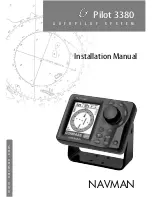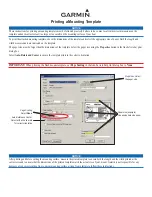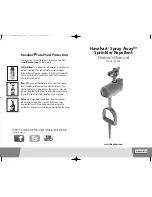
3
4
Beltpack Transmitter and Mic Description
Vi s i t u s o n l i n e a t
c a l i fo n e. co m
Infrared Ceiling Sensors
(two units are included)
(1) Receiver Cover
(2) Fixed Ear
(3) Infrared External Input
(4) Infrared External Output
(5) Signal Cable with 32’ cord
2
1
2
1
3
4
5
Connects to receiver panel
General
Specifications
Modulation
Frequency Response
SNR
Power Output
Distortion
Infrared Microphone
Transmitting Mode
Transmitting Frequency
Transmitting Range
Battery
Current Consumption
Infrared Receiver
Receiving Mode
Receiving Frequency
AF Output
Dimensions
FM
50Hz~15KHz 3dB
80dB
50W MAX
less than 1%
Infrared
2.35MHz or 2.85Mhz
40 feet
2x1.2V rechargeable batteries
240mA
Infrared
2.35MHz or 2.85MHz
650mV AF 1KHz
(L)270x (W)120x(H)300mm
Parts Description
Receiver
Beltpack Transmitter
Transmits Voice to the Infrared Ceiling Sensors
(1) Power Switch
(2) Fuse
(3) LINE OUT
(4) Unbalanced MIC-IN
(5) Balanced MIC-IN
(6) Condenser MIC-IN
(7) AUX IN
(8) MIC-1 Volume Control
(9) MIC-2 Volume Control
& Infrared MIC Volume Control
& Condenser MIC Volume Control
(10) Treble Control
(11) Bass Control
(12) AUX IN VOL Control & Power Switch
(13) Belt-pack Transmitter(charging place)
(14) RF LED Indicator
(15) Power LED Indicator
(16) Lock
(17) Ceiling Sensor Cable Plugs
(18) EXT Speaker Jack
(19) Front Cover
(20) AC Cord
A.Front Panel
B.Rear Panel
(1) Power LED Indicator
(2) Power Switch
(3) Battery Cover
(4) Infrared Transmitting Head
(5) MIC-IN Jack
(6) DC-IN Jack/Battery Charger
(7) Volume Control
(8) Belt Clip
(9) Battery Compartment
(5)
(4)
(1)
(2)
(3)
(6)
(7)
(8)
(9)
(1) (2)
(3)
(4)
(5)
(6)
(7)
(8)
(9)
(10)
(11)
(12)
(13)
(14)
(15)
(16)
(19)
(17) (18)
(20)
Installation
Vi s i t u s o n l i n e a t
c a l i fo n e. co m
Infrared Ceiling Sensors
(two units are included)
(1) Receiver Cover
(2) Fixed Ear
(3) Infrared External Input
(4) Infrared External Output
(5) Signal Cable with 32’ cord
2
1
2
1
3
4
5
Connects to receiver panel
General
Specifications
Modulation
Frequency Response
SNR
Power Output
Distortion
Infrared Microphone
Transmitting Mode
Transmitting Frequency
Transmitting Range
Battery
Current Consumption
Infrared Receiver
Receiving Mode
Receiving Frequency
AF Output
Dimensions
FM
50Hz~15KHz 3dB
80dB
50W MAX
less than 1%
Infrared
2.35MHz or 2.85Mhz
40 feet
2x1.2V rechargeable batteries
240mA
Infrared
2.35MHz or 2.85MHz
650mV AF 1KHz
(L)270x (W)120x(H)300mm
Parts Description
Receiver
Beltpack Transmitter
Transmits Voice to the Infrared Ceiling Sensors
(1) Power Switch
(2) Fuse
(3) LINE OUT
(4) Unbalanced MIC-IN
(5) Balanced MIC-IN
(6) Condenser MIC-IN
(7) AUX IN
(8) MIC-1 Volume Control
(9) MIC-2 Volume Control
& Infrared MIC Volume Control
& Condenser MIC Volume Control
(10) Treble Control
(11) Bass Control
(12) AUX IN VOL Control & Power Switch
(13) Belt-pack Transmitter(charging place)
(14) RF LED Indicator
(15) Power LED Indicator
(16) Lock
(17) Ceiling Sensor Cable Plugs
(18) EXT Speaker Jack
(19) Front Cover
(20) AC Cord
A.Front Panel
B.Rear Panel
(1) Power LED Indicator
(2) Power Switch
(3) Battery Cover
(4) Infrared Transmitting Head
(5) MIC-IN Jack
(6) DC-IN Jack/Battery Charger
(7) Volume Control
(8) Belt Clip
(9) Battery Compartment
(5)
(4)
(1)
(2)
(3)
(6)
(7)
(8)
(9)
(1) (2)
(3)
(4)
(5)
(6)
(7)
(8)
(9)
(10)
(11)
(12)
(13)
(14)
(15)
(16)
(19)
(17) (18)
(20)
Speakers
CAUTION
: The included PI30-SP speakers have a total impedance of
about 5.3 ohms when connected in parallel. Therefore, no more
than 2pcs PI30-SP should be connected to the PA-IRSYS to avoid
the impedance dropping too low for the amplifier output. Speakers
with higher impedance ratings can be used as long as the total
load impedance on the amplifier is not below approximately
3 ohms.
1.
Install each of the PI30-SP non-powered speakers on
the front & back walls of the room. Optimal placement is
approximately 3 feet below the ceiling in the middle of
the wall.
Note:
If the PA-IRSYSB package has been purchased, then 4
speakers (2 non-powered + 2 powered) can be connected to
the PA-IRSYS Control Panel. The PI30-SP (non-powered) speakers
should be connected as described above. The PI30-PS speakers
should be connected as follows:
1.
Install the PI30-PS speakers on the wall in the desired locations.
2.
Connect the line output (1/4”) of the control panel to one of
the line inputs on one of the PI30-PS speakers (RCA jacks).
3.
Connecting the second PI30-PS speaker:
4.
Option 1:
The speakers can be daisy-chained by connecting
one of the line outputs (variable or fixed) on one PI30-PS
speaker to the line input of the other PI30-PS speaker.
5. Option 2:
A splitter may be put on the line output from
the control panel so that each PI30-PS speaker is fed with
its own cable.
6.
Volume adjustment: Depending on if the speakers are
daisy chained and if the fixed or variable line outputs,
were used, the method to adjust the volume will be
different. Adjust the volume levels of each of the speakers
to achieve a balanced sound field in the listening area.
Infrared Ceiling Sensors
1.
Install the two included infrared ceiling sensors along
an imaginary center line in the middle of the ceiling, with
each sensor located approximately one third of the length
of the room away from the back or front wall.
Note:
With proper installation, the Classroom Audio system
(with two ceiling sensors) can be used in rooms up to 2,000 sq.
feet in size. If greater coverage is needed, up to 4 ceiling sensors
can be daisy-chained & connected to the control panel.
Tip:
If reception of the infrared microphones is noisy or the
signal cuts out, try moving and/or rotating the receivers until
better reception is obtained.
Control Panel
The Control Panel has two possible mounting configurations:
1.
Option 1:
The default configuration is the surface-
mount the box on the wall. The mounting ears are
designed with 4 holes for screws. Wall anchors or other
hardware should be used as necessary to securely
attach the box to the wall.
2.
Option 2:
The second configuration is a flush-mount. The
mounting ears can be unscrewed, flipped around and
unscrewed into the holes towards the front of the box.
In this configuration, a hole will need to be made in
the wall the same size as the control panel. The control
panel will protrude from the wall only enough to allow
for the door to open fully.
Tips:
•
Install the panel in an accessible area of the classroom
where computers and other external media sources
can be easily connected to the panel.
•
Note that longer runs of cable and poorly shielded
cable can cause hum or other noise to enter the system
and output through the speakers and other outputs.
•
Plug the power of different equipment into the same
power outlet when possible to avoid ground loops. Also
see “Connecting the System” on the right side of the
inner door panel.
Connecting the System Once the
Control Panel is Installed
Note
: The connections described in the following section
are found on the the inside facing panel of the control box.
1.
Connect the two PI30-SP speakers to the
Speaker
Output Jacks
(28, 29).
2.
Connect the two individual or daisy-chained signal
cables from the infrared ceiling sensors to the
Infrared
Ceiling Sensor Jacks
(30, 31).
3.
Connect the AC power cord to the
Power Connector
(34) on the bottom of the Control Panel and then to the
wall outlet.
4.
If an external amplifier or assistive listening system is
used, connect the amplifier/assistive listening system
input to the
Line Output Jack
(23).
5.
When using an external sound source (such as a DVD/
VCR, computer or a Califone® media player), connect
the output from the media source to one of the
Aux In
Jacks
(22, 24). Depending on the cable you have and
the output jack type of the external source, you may
use either 3.5mm jack (Aux 1) or the RCA jacks (Aux 2). All
HBM-316
microphone
shown with
PI30-BP
beltpack transmitter
PI30-HH
handheld student
microphone
califone_PA-IRSYS_manual_Rev2.indd 6-7
3/12/2010 12:40:05 PM
























